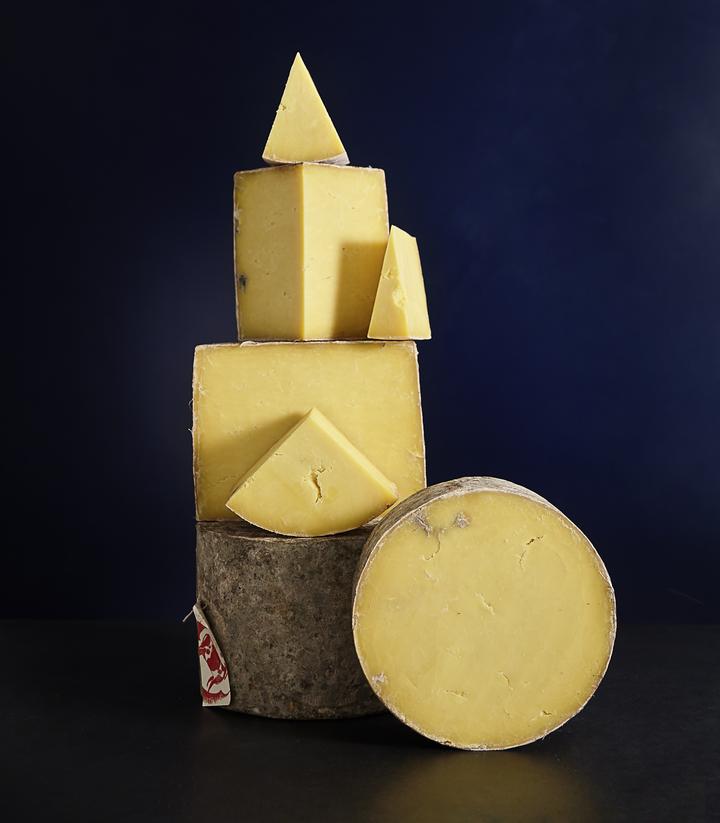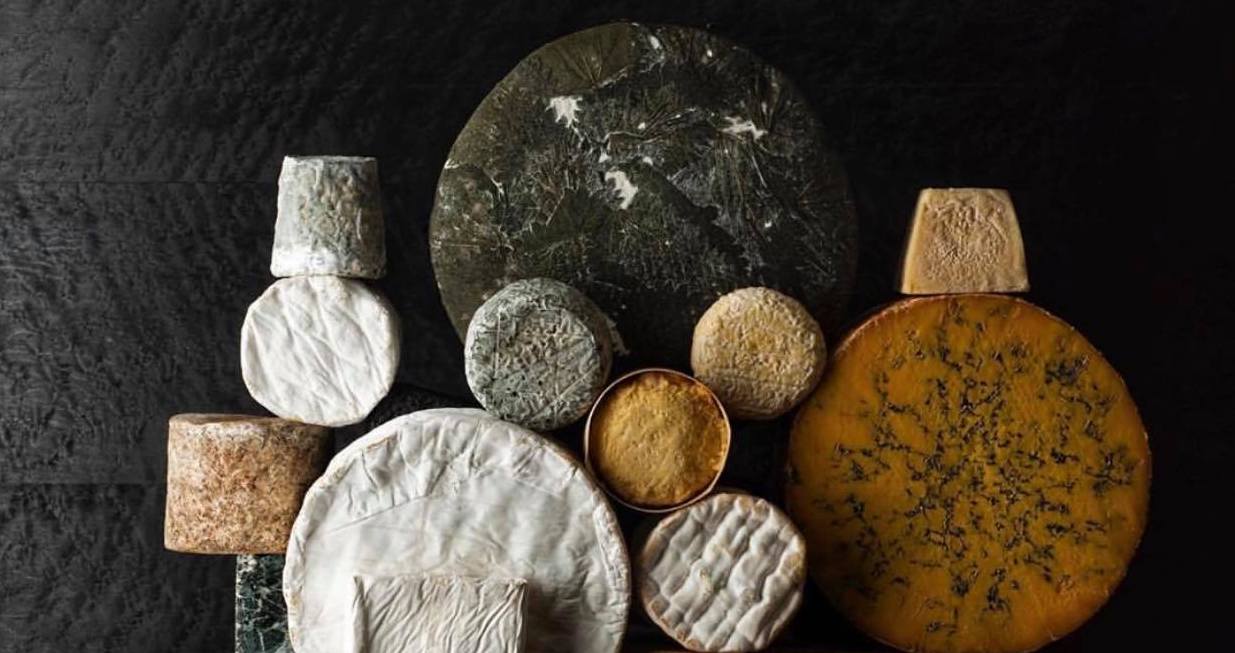Say cheese. Now, say ‘British Cheese’ and what comes to mind? A nice bit of Cheddar? A wedge of Stilton? Fair enough; but would you be surprised to know there are now no fewer than 800 British and Irish cheeses, many of them new?
There has been an upsurge in cheesemaking in Britain. Some of the new cheeses are novelties in conception and technique, others are Continental European in style but there has also been a welcome return of at least some old fashioned and excellent county cheeses, like Cheshire (once the aristocrat of cheeses), Gloucester, Leicester and Caerphilly. It’s been an astonishing phenomenon and it has happened over quite a short time, in the last two or three decades, while most of us weren’t looking.
Cheesy people are using terms like terroir to describe the connection between the soil and character of a place and its milk and cheese, a word which normally is associated with wine. Patricia Michelson of cheesemongers La Fromagerie observes, ‘there is so much more to cheesemaking now; it’s about understanding place, seasonality, traditional recipes and maturing.’ As Hero Hirsh, of Paxton and Whitfield, observes, ‘this is a really exciting time for British cheese; possibly the most exciting time.’
That remarkable upward trajectory faltered over the last couple of years, though, on account of Brexit and the Covid pandemic. The former drastically put up prices for exporters; the latter nearly killed off small independent producers when the restaurant and hotel trade vanished.
But specialist cheese retailers, a collaborative bunch, rallied round producers. ‘There was a kind of triage among cheesemongers’, said Hero Hirsh, ‘where one would take charge of a producer who was at risk, and perhaps buy his stock, or promote him. There was a lot of creativity.’ Neal’s Yard, the retailer which helped create the new wave of British cheese in the Seventies, collaborated with Jamie Oliver: he encouraged his online followers to buy British cheese boxes from endangered makers and Neal’s Yard sent them a kilo of quality British cheese for under thirty pounds. It was a success; in one month they sold 14,000 boxes. The move online for cheese selling was unprecedented.
The industry still needs support so if you like cheese, go head for your nearest cheesemonger and buy something fabulous and keep buying it. But how to navigate all that choice, all those new varieties?

One person who knows what’s good is Ned Palmer, whose excellent Cheesemonger’s Guide to the British Isles was an unexpected bestseller last year; he’s now bringing out a compendium of British and Irish cheeses, a book that promises to be fatter with every edition. How would he describe modern British cheese? ‘Postmodern’, he says, tongue in cheek. The first wave in the Seventies was Continental in style, because so much British knowledge and traditional methods had been lost: Tynsborough goat cheese was one example. ‘Then there’s the promiscuous, multicultural cheese which borrow aspects of foreign cheese and mix them with our traditions’, he says. ‘Lincolnshire Poacher, a wonderful cheese, is a love child of Cheddar and Gruyere. And there are completely novel cheeses, such as Renegade Monk, a mixture of washed rind, like a Vacherin, and a blue cheese. No previous blue cheese had a washed rind.’
Finally, there’s what’s known as Territorials, or the old farmhouse regional cheeses, almost lost because of a combination of pressures, from enclosures to the formation of the Milk Marketing Board (which pooled milk), wartime rationing and assorted food scares which saw off many raw milk producers. ‘These are a unique family of cheeses such as Cheshire and Wensleydale’, he says. ‘These were high end, gourmet products; Cheshire was huge…T.S. Eliot thought it the finest cheese’. Now there’s just two raw Cheshire farmhouse producers. The trouble about this kind of cheese for a modern palate is that they’re relatively mild, which can seem bland. But, says Ned Palmer. ‘If you give people Wensleydale, you’ll get a beatific smile’.
What you don’t take on board if you just buy cheese from supermarkets is that many cheeses are seasonal; perhaps made with summer milk
Jason Hinds, of Neal’s Yard Dairy, thinks that these cheeses are meant to be served as part of a meal, paired with good bread and pickle and chutney; in that context they sing. Andy Swinscoe of the Courthouse Dairy in Yorkshire, says, ‘these cheeses aren’t in your face but if they’re made with lovely quality milk, they can be really interesting and complex. People may think they like powerful big flavours like a Cheddar or something sweet and nutty but sometimes these are too rich. If I’m hungry, I’d go for a Lancashire. These cheeses should be eaten first in a cheeseboard; otherwise they get overpowered.’
What you don’t take on board if you just buy cheese from supermarkets is that many cheeses are seasonal; perhaps made with summer milk. Right now, Andy Swinscoe is keen on St James’s, an unpasteurised sheep’s milk cheese, because it’s eating really well and he hasn’t had it for a year. Patricia Michelson is keen on Beenleigh Blue, a ewe cheese – ‘it’s new season cheese so tastes fresh and zingy’. By Christmas it’ll be different.
Jason Hinds has noticed that there’s a different demographic now when it comes to British and Irish cheese…younger, more cost conscious and not necessarily cheese aficionados. The experiment of getting cheese out during lockdown to Jamie Oliver’s Instagram followers was revelatory. ‘For some of them, it was the first time they’d had cheese of real quality, and they absolutely loved it. The whole thing made us think about reaching a different audience.’
There are grounds for optimism that a new generation will embrace modern British cheese. The producers, many of them small independents, passionately committed to their soil and their livestock, happen to be doing all the things that resonate with the environmentally conscious. ‘The issues that really concern that generation’, says Jason Hinds, ‘like sustainability, carbon footprint and animal welfare, are those we’ve always cared about. If you don’t look after your animals and feed them properly, you won’t get good cheese.’
Sustainability is in fact a real feature of the new cheesemaking. One critical issue for biodiversity is pastoral monoculture – farmers growing just one kind of grass, usually rye, and excluding all other varieties of grasses, herbs and flowers. But it’s exactly this kind of meadow that makes for healthy cows and good milk. In environmental terms, there’s a world of difference between cows that are kept indoors much of the year and fed on maize or poor quality silage, and those that graze on natural mixed pasture, or herbal leys for all but the wet months (there’s more wetness up north). The environmental benefits are huge.
So…what cheese to buy and where to buy it from? There are any number of independent cheesemongers selling only or mostly British and Irish cheeses – that itself is an astonishing change. If you’ve got a local independent retailer, support them; otherwise, these suppliers are excellent; many do tastings, virtual and real, or monthly subscriptions, to get the seasonal best:
Neal’s Yard Dairy is the great retailer behind much of the new wave of British cheesemaking, and supports any number of wonderful small producers: nealsyarddairy.co.uk
Paxton and Whitfield is a particular favourite; it’s over 200 years old and has a choice selection of British as well as Continental cheeses and very good hampers: paxtonandwhitfield.co.uk
The Courtyard Dairy, Yorkshire: Andy Swincoe and his wife Kathy have had umpteen deserved awards for their thoughtful and interesting selection of farmhouse and small producer cheeses, and friendly approach: thecourtyarddairy.co.uk
The Fine Cheese Company has a wonderful range of artisan cheeses, with an excellent British as well as Continental selection. finecheeseshops.co.uk
La Fromagerie has an excellent online selection with some really inviting cheese boxes – curated selections to make it easier to choose, including a Women in Cheese range; the British box is very good. lafromagerie.co.uk
The Bristol Cheesemonger specialises in local, seasonal British cheese and it’s especially good on West Country producers. bristol-cheese.co.uk
And what cheeses to choose? Oh my, it’s tough. Let me suggest some of the most obviously outstanding cheeses (all but one unpasteurised), then some suggested by Ned Palmer and Andy Swinscoe from suppliers who have very good environmental credentials for their grassfed herds (NB, this doesn’t mean the rest do not).
Very good cheese:
Stilchelton: this is Stilton only it’s made with raw milk and outstanding in flavour and complexity.
Tunworth: described by Raymond Blanc as the best Camembert in the world, a remarkably punchy soft cheese, excellent baked, and the only pasteurised product I’m including.
Sinodun Hill: a new, delicious and zingy goat’s cheese with a lovely light texture.
St James’s: a modern classic, made with sheep’s milk; square shape.
Lincolnshire Poacher: Somerset tradition crossed with Alpine cheesemaking. Nutty and delicious.
Gorwydd Caerphilly: A creamy exterior and crumbly interior, matured longer than most. Lovely.
Isle of Mull Cheddar: From cattle partly fed on the barley mash used for whisky making; this is a pale and fine cheddar; not too assertive.
Corra Linn: made with raw sheep’s milk…hard and nutty like Manchego, only made in Lanark. Yum.
Very good cheese from grass fed herds with sound sustainability credentials:
Hafod Cheddar: Andy Swinscoe describes this as “a really ethically and sustainably made Cheddar that has a real richness and depth of flavour provided by their diverse pastures”.
Coolattin: this is something of a rarity, a raw milk Irish cheese (health and safety is even more onerous for makers of unpasteurised cheese there). This, says Ned Palmer, is “only from pasture and only from the morning milk”. Lovely savoury cheddar.
Stonebeck Wensleydale: Made from milk from Northern Dairy Shorthorns, an indigenous breed, on Nidderdale. A traditional recipe from a lady of 101, the last maker of pre-war Wensleydale.
Hebden Goat: a fresh mild goat’s cheese from a herd of only ten animals that graze on the Pennines.






Comments